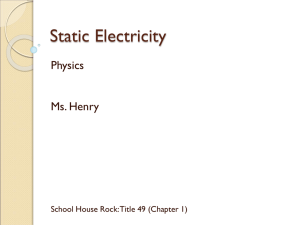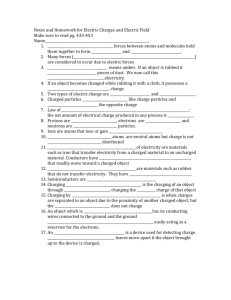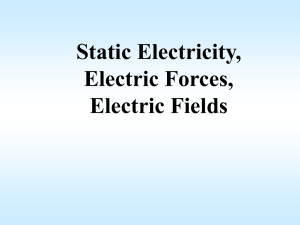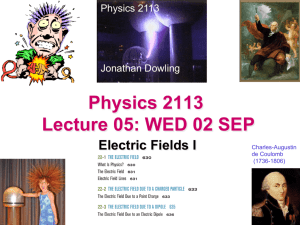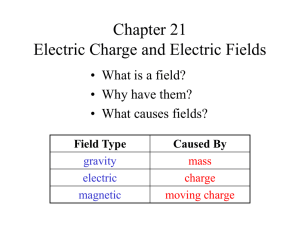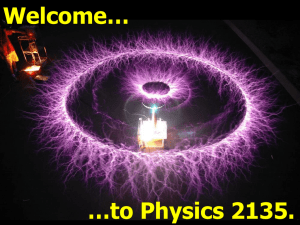ELEC 3105 Lecture 1 Slides
advertisement
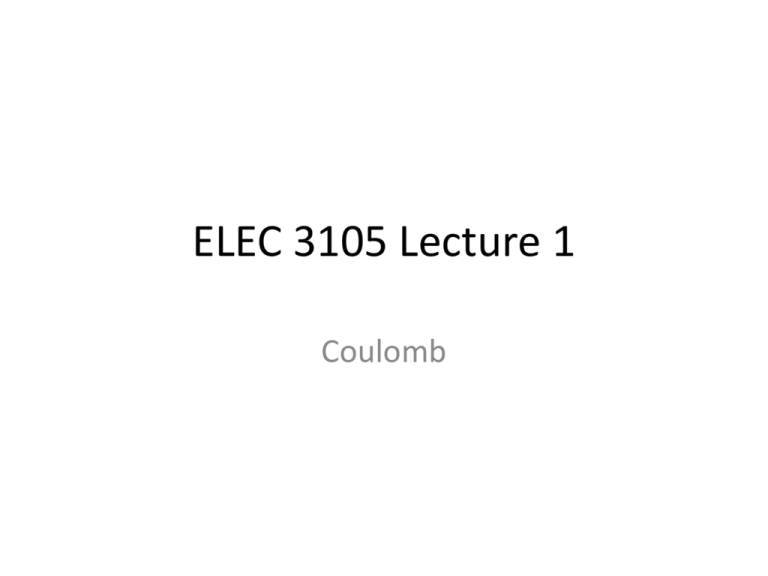
ELEC 3105 Lecture 1
Coulomb
4. Electrostatics
Applied EM by Ulaby, Michielssen and Ravaioli
Chapter 4 Overview
Maxwell’s Equations
God said:
And there was light!
Current Density
For a surface with any orientation:
J is called the current density
ELEC 3105 Lecture 1
Coulomb’s Law
Electric field at point P due to single charge
Electric force on a test charge placed at P
Electric flux density D
Coulomb’s force law (point charges)
q1
r12 r2 r1
q2
r1
r2
F
origin
[F]-force; Newtons {N}
[q]-charge; Coulomb {C}
[r]-distance; meters {m}
[]-permittivity; Farad/meter {F/m}
kq1q2
F12 2 r12
r12
Property of the medium
Coulomb’s force law (permittivity)
For a medium like air
medium 1.0006 o
Relative permittivity
medium
r
o
Coulomb’s force law (permittivity)
medium o
k
FORCE IN MEDIUM SMALLER
THAN FORCE IN VACUUM
1
4medium
kq1q2
F12 2 r12
r12
Lecture 1 (ELEC 3105)
Basic E&M and Power
Engineering
Coulomb's Law
The force exerted by one point charge on another acts along the line joining
the charges. It varies inversely as the square of the distance separating the
charges and is proportional to the product of the charges. The force is
repulsive if the charges have the same sign and attractive if the charges
have opposite signs.
Action at a distance
Electric Field Due to 2 Charges
Example of (4.18) next
Electric Field due to
Multiple Charges
Electric field (charge distribution)
qi
z
r ri
ri
q3
q1
P
q2
r
qN
q4
y
Large number N
of point charges
x
q5
r ri
E k qi 3
r ri
i 1
N
PRINCIPLE OF SUPERPOSITION
Given a group of charges we find the net electric field at
any point in space by using the principle of
superposition. This is a general principle that says a net
effect is the sum of the individual effects. Here, the
principle means that we first compute the electric field
at the point in space due to each of the charges, in turn.
We then find the net electric field by adding these
electric fields vectorially, as usual.
Charge Distributions
Volume charge density:
Total Charge in a Volume
Surface and Line Charge Densities
Electric Field Due to Charge
Distributions
Field due to:
Electric field (charge distribution)
q
Charged volume
Charge always occurs in integer
multiples of the electric charge
e = 1.6X10-19C.
Charged surface
Charged line
It is often useful to imagine that
there is a continuous
distribution of charge
Electric field (charge distribution)
P
Charge volume element dV
q
Charged volume
The electric field at the point P is obtained by
summing the electric field contribution from
from each volume element dV.
V
Volume charge density
V
V dV
Units; {C/m3 }
Charge in dV
When the volume element
dV--> 0
Sum --> Integral
Electric field (charge distribution)
P
V
dV
dE
r
Field for one element
V
rkdq
dE 2
r
Charged volume
With
rkV dV
dE
2
r
dq V dV
Integration over
volume V
r kV dV
E dE 2
r
V
V
Electric field (charge distribution)
V may be a function of the coordinates
usually a constant
dV dxdydz,.....
unit vector
function of (x,y,z),….
r kV dV
E dE 2
r
V
V
2
2
2
r x y z ,....
k
1
4
usually a constant when medium is uniform
Electric field (charge distribution)
P
dS
q
Charged surface
The electric field produced at the point P is:
Charge surface element dS
s
Surface charge density
s
s dS
Units; {C/m2}
Charge on dS
r k s dS
E dE 2
r
S
S
Electric field (charge distribution)
s may be a function of the coordinates
usually a constant
dS dxdy,.....
unit vector
function of (x,y,z),….
r k s dS
E dE 2
r
S
S
2
2
2
r x y z ,....
k
1
4
usually a constant when medium is uniform
Electric field (charge distribution)
P
d
q
Charged line
Charged line element d
Linear charge density
d
The electric field produced at the point P is:
Units; {C/m}
Charge on
d
r k d
E dE 2
r
L
L
Electric field (charge distribution)
may be a function of the coordinates
usually a constant
d dx,.....
unit vector
function of (x,y,z),….
r k d
E dE 2
r
L
L
2
2
2
r x y z ,....
k
1
4
usually a constant when medium is uniform
Cont.
Cont.
Example 4-5 cont.


